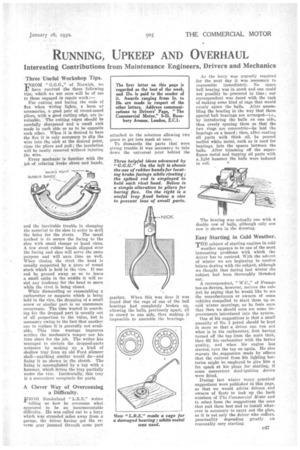RUNNING, UPKEEP AND OVERHAUL
Page 69

If you've noticed an error in this article please click here to report it so we can fix it.
Interesting Contributions from Maintenance Engineers, Drivers and Mechanics
Three Useful Workshop Tips.
FROM" G.G.G.," of Norwich, we have received the three following tips, which we are sure will be of use to those engaged in repair work.:—
For cutting and baring the ends of flex when wiring lights, a horn or accessories, a good pair of round-nosed pliers, with a good cutting edge, are invaluable. The cutting edges should be carefully sharpened and a small nick made in each side so as to be opposite each other. When it is desired to bare the flex it is only necessary to slip the wire into the nick at the desired point, close the pliers and pull; the insulation will be neatly removed without injuring the wire.
Every mechanic is familiar with the job of refacing brake shoes and bands, and the inevitable trouble in clamping the material to the shoe in order to drill
the holes for the rivets. The usual method is to secure the facing to the shoe with small clamps or hand vices. A few stout rubber bands slipped over the facing and shoe will serve the same purpose and will save time as well. When closing the rivet the head is usually supported by a piece of round stock which is held in the vice. If one end be ground away, so as to leave a small spike in the middle it will resist any tendency for the head to move while the rivet is being closed.
While dismantling or reassembling a carburetter or magneto which is being held in the vice, the dropping of a small screw or similar part is no uncommon occurrence. The time wasted in searching for the dropped part is usually out of all proportion to the value, but is necessary owing to the fact that another one to replace it is generally not available. This time wastage improves neither the mechanic's temper nor his time sheet for the job. The writer has managed to obviate the dropped-parts nuisance by making up a kind of shallow tray from an old Ford silencer shell—anything similar would do—and fixing it as shown in the sketch. The fixing is accomplished by a tap with a hammer, which drives the tray partially under the vice. Incidentally, this tray is a convenient receptacle for parts.
A Clever Way of Overcoming a Difficulty.
FROM Sunderland " L.R.E." writes telling us how he overcame what appeared to he an insurmountable difficulty. He was called out to a lorry which was stranded miles away from a garage, the driver having got the reverse gear. jammed through some part attached to the selectors allowing two gears to get into mesh at once.
To dismantle the parts that were giving trouble it was necessary to take down the miiversal joint behind the gearbox. When this Was done it was found that the cage of one of the ball bearings had completely broken up, allowing the balls, previously apart, all to crowd to one side, thus making it impossible to assemble the bearings. As the lorry was urgently required for the next day it was necessary to reassemble immediately. No spare ball bearing was in stock and one could not possibly be procured in time ; our correspondent was faced with the task of making some kind of cage that would evenly space the balls. After assembling the bearing in the way that these special ball bearings are arranged—i.e., by introducing the balls on one side, then evenly spacing them so that tho two rings are concentric—he laid the bearings on a board ; then, after coating all parts with thick oil, he poured melted white metal, such as is used for bearings, into the spaces between the balls. After trimming off the superfluous metal and tapping all parts with alight hammer he balls were induced to roll.
Easy Starting in Cold Weather.
THE subject of starting engines in cold weather appears to be one of the most interesting problems with which the driver has to contend. With the advent of winter we are beginning to receive letters dealing with the subject, although we thought that during last winter the subject had been thoroughly thrashed Out.
A correspondent, " W.C.," of Frampton-on-Severn, however, revives the subject by saying that he would like to see the manufacturers or owners of some vehicles compelled to start them up on. cold winter mornings, as he feels sure that then we should soon see some improvements introduced into the system.
One of his suggestions is that a small quantity of No. 1 petrol should be kept in store so that a driver can run out what is in his carburetter, first having turned off the tap from the main tank, their fill his carburetter with the better quality, and when his engine has started, turn the tap on again. He also repeats the suggestion made by others that the current from his lighting batteries might be employed to give him a fat spark at his plugs for starting, if some convenient dual-ignition device were fitted.
During last winter many practical suggestions were published in this page, so that we would advise drivers and owners of fleets to look up the back numbers of The Commercial Motor and to select from the suggestions the ones that suit them best and to install whatever is necessary to carry out the plan, as it is not only the driver who suffers, punctuality depending greatly on reasonably easy starting.












































































































